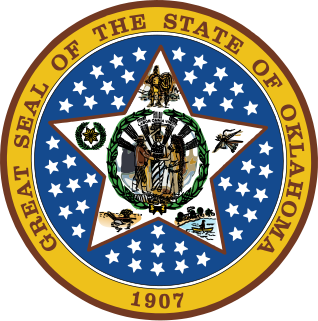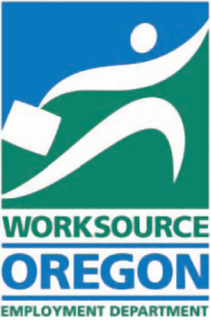Unemployment benefits are payments made by back authorized bodies to unemployed people. In the United States, benefits are funded by a compulsory governmental insurance system, not taxes on individual citizens. Depending on the jurisdiction and the status of the person, those sums may be small, covering only basic needs, or may compensate the lost time proportionally to the previous earned salary.
The Job Training Partnership Act of 1982 was a United States federal law passed October 13, 1982, by the United States Department of Labor during the Ronald Reagan administration. The law was the successor to the previous federal job training legislation, the Comprehensive Employment and Training Act (CETA). It was repealed by the Workforce Investment Act of 1998 during the administration of President Bill Clinton.
The Workforce Investment Act of 1998 was a United States federal law that was repealed and replaced by the 2014 Workforce Innovation and Opportunity Act.

The Employment and Training Administration (ETA) is part of the U.S. Department of Labor. Its mission is to provide training, employment, labor market information, and income maintenance services. ETA administers federal government job training and worker dislocation programs, federal grants to states for public employment service programs, and unemployment insurance benefits. These services are primarily provided through state and local workforce development systems.
Pennsylvania CareerLink is a collaborative project between multiple agencies to provide career services to Pennsylvania employers, potential employees, and others.

The Oklahoma Employment Security Commission (OESC) is an independent agency of the state of Oklahoma responsible for providing employment services to the citizens of Oklahoma. The Commission is part of a national network of employment service agencies and is funded by money from the United States Department of Labor. The Commission is also responsible for administering the Workforce Investment Act of 1998 on behalf of the state.
The Employment Development Department (EDD) provides a variety of services to businesses, workers, and job seekers. The EDD administers several multi-billion dollar benefit programs including the Unemployment Insurance (UI), Disability Insurance (DI), and Paid Family Leave (PFL) programs that provide financial stability to workers and their communities. The Department also provides critical employment service programs to Californians, collect the state’s labor market information and employment data, and serve as one of the nation’s largest tax agencies through our collection of payroll taxes.
Dale Rogers Training Center (DRTC), a non-profit organization, is the oldest and largest community vocational training and employment center for individuals with disabilities in Oklahoma. With five locations in Oklahoma, Dale Rogers Training Center trains or employs 1100 people a year: more than 900 with disabilities.
Iowa Workforce Development is a government agency in the American state of Iowa, responsible for overseeing workplace safety, workers' compensation, unemployment insurance and job training services. It was formed in May 1996.
The Ohio Department of Job and Family Services (ODJFS) is the administrative department of the Ohio state government responsible for supervising the state's public assistance, workforce development, unemployment compensation, child and adult protective services, adoption, child care, and child support programs. Prior to July 2013, ODJFS was also the state agency responsible for the administration of Ohio's Medicaid program. In July 2013, a new state agency was created, the Ohio Department of Medicaid (ODM), Ohio’s first Executive-level Medicaid agency. ODJFS employs about 2,300 full time employees and has an annual budget of $3.3 billion.
The Minnesota Department of Employment and Economic Development (DEED) is the State of Minnesota’s principal economic development agency. Its mission includes supporting the economic success of individuals, businesses, and communities by improving opportunities for growth.

The Texas Workforce Commission is a governmental agency in the U.S. state of Texas that provides unemployment benefits and services related to employment to eligible individuals and businesses.
The Georgia Department of Labor is an administrative agency of the U.S. state of Georgia. With approximately 4,000 employees in 2008, it provides services to the state's current and emerging workforce.
Pathways Out of Poverty (POP) is a national workforce development program that was established on August 14, 2009, by the Obama administration and funded by the American Recovery and Reinvestment Act (ARRA) of 2009. The Department of Labor's Employment and Training Administration announced POP grantees on January 13, 2010. POP targets individuals living below or near the poverty level to provide them with skills needed to enter the green job market, focusing on the energy efficiency and renewable energy industries. The training programs focus on teaching basic literacy and job readiness skills. Some of the programs also provide supportive assistance with childcare and transportation to overcome barriers to employment.
YMCA Training, Inc. is a non-profit organization in Boston that provides access to employment to low-income unemployed adults through technical and office support skills training. The Boston program is part of a national network of local job training organizations called Training, Inc. National Association, which provides resources to organizations in the workforce development field. Other Training, Inc. member sites are currently located in Chicago, Indianapolis, and Newark.
Welfare in California consists of federal welfare programs—which are often at least partially administered by state and county agencies—and several independent programs, which are usually administered by the counties.
Energy Trust of Oregon is an independent nonprofit organization based in Portland, Oregon that helps utility customers in Oregon benefit from efficient energy use and generating renewable energy. Energy Trust offers services, cash incentives and other energy solutions to customers of Portland General Electric, Pacific Power, NW Natural and Cascade Natural Gas in Oregon and customers of NW Natural in Washington.

The Workforce Innovation and Opportunity Act (WIOA) is a United States public law that replaced the previous Workforce Investment Act of 1998 (WIA) as the primary federal workforce development legislation to bring about increased coordination among federal workforce development and related programs.
Unemployment in Hungary measured by the Hungarian Central Statistical Office shows the rate of unemployed individuals out of the labor force. The European Union's own statistical office, Eurostat also makes reports and predictions about the Hungarian job market and the unemployment rate in the country. The KSH's most recent unemployment data shows the unemployment rate for men 15-74 to be 3.3% and 4.1% for women.









